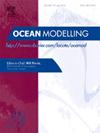Inferring diapycnal mixing using the internal wave continuum from the high resolution ocean model
IF 2.9
3区 地球科学
Q2 METEOROLOGY & ATMOSPHERIC SCIENCES
引用次数: 0
Abstract
Internal wave (IW)-induced mixing plays a crucial role in maintaining the thermohaline circulation. However, as most ocean general circulation models (OGCMs) do not resolve the scales of IWs and turbulence, to appropriately express the IW-induced turbulent dissipation is a long-lasting issue for ocean model development. Here we report the estimates of IW-induced turbulent dissipation in the South China Sea (SCS), from a tide-included OGCM using an internal wave continuum parameterization scheme (IWCP). The estimation is based on the energy level of internal wave continuum (IWC), by converting the finescale parameterization (FSP) from wavenumber to the frequency domain. The estimated dissipation rates are elevated over the Luzon Strait (LS), northern SCS, and continental slopes, up to O(10−7) Wkg−1 between 100 and 500 m depth, while those in the central basin of SCS are O(10−10) Wkg−1. The performance of IWCP are evaluated against observational datasets (Argo, CTD based FSP estimates, and CTD based Thorpe scale method estimates) and tidal-mixing parameterization schemes. The errors in IWCP's results are comparable with the discrepancies among different observational datasets. The IWCP significantly outperforms the widely used tidal mixing parameterization that only considers local internal tides, and are comparable, if not superior, to the tidal mixing parameterization that consider both local and non-local generation, depending on the choice of benchmark observational datasets. This work illustrates that IWCP could be an alternative efficient mean to estimate the three-dimensional map of IW-induced mixing from the high resolution OGCM.
利用高分辨率海洋模式的内波连续体推断潜流混合
内波混合在维持温盐环流中起着至关重要的作用。然而,由于大多数海洋环流模式(ogcm)没有解决IWs和湍流的尺度,因此如何恰当地表达IWs引起的湍流耗散是海洋模式发展的一个长期问题。本文报道了利用内波连续体参数化方案(IWCP)从包含潮汐的OGCM中估计南海(SCS) iw诱导的湍流耗散。该方法基于内波连续体(IWC)的能级,将细尺度参数化(FSP)从波数转换为频域。吕宋海峡(LS)、南海北部和大陆斜坡的估计耗散率在100 - 500 m深度达到0(10−7)Wkg−1,而南海中部盆地的估计耗散率为0(10−10)Wkg−1。根据观测数据集(Argo、基于CTD的FSP估计和基于CTD的Thorpe尺度方法估计)和潮汐混合参数化方案对IWCP的性能进行了评估。IWCP结果中的误差与不同观测数据集之间的差异具有可比性。IWCP显著优于广泛使用的仅考虑局部内部潮汐的潮汐混合参数化,并且与考虑局部和非局部生成的潮汐混合参数化相当,如果不是优于,这取决于基准观测数据集的选择。这项工作表明,从高分辨率OGCM中估计iw诱导混合的三维图,IWCP可以是一种替代的有效方法。
本文章由计算机程序翻译,如有差异,请以英文原文为准。
求助全文
约1分钟内获得全文
求助全文
来源期刊

Ocean Modelling
地学-海洋学
CiteScore
5.50
自引率
9.40%
发文量
86
审稿时长
19.6 weeks
期刊介绍:
The main objective of Ocean Modelling is to provide rapid communication between those interested in ocean modelling, whether through direct observation, or through analytical, numerical or laboratory models, and including interactions between physical and biogeochemical or biological phenomena. Because of the intimate links between ocean and atmosphere, involvement of scientists interested in influences of either medium on the other is welcome. The journal has a wide scope and includes ocean-atmosphere interaction in various forms as well as pure ocean results. In addition to primary peer-reviewed papers, the journal provides review papers, preliminary communications, and discussions.
 求助内容:
求助内容: 应助结果提醒方式:
应助结果提醒方式:


